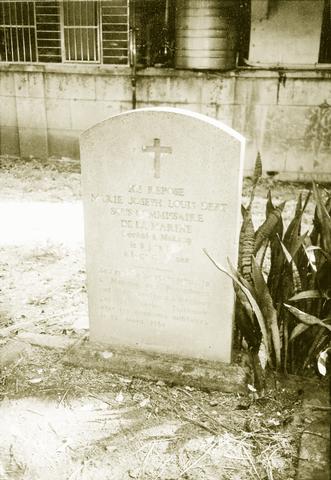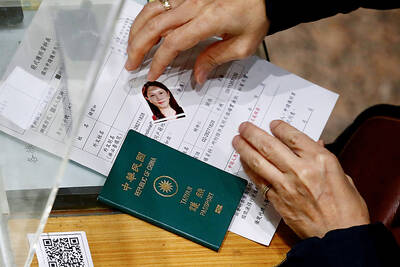Keelung has a long history of contact with the West -- at various times the port has hosted a Spanish garrison, a Dutch trading post, and a British consulate -- but many visitors overlook the port's French cemetery, a relic of the Sino-French War of 1884 to 1885 located on a city plot hemmed in by buildings near the ruins of Ershawan Fort (
Part of the significance of this graveyard lies in it being the largest concentration of foreign remains in Taiwan, with the exception of Taichung City's Paochueh Temple (寶覺寺), where the bones of Japanese nationals who died during the colonial period were reburied after World War II.

PHOTO: STEVEN CROOK
The French cemetery is the subject of a new book by Christophe Rouil titled Formosa: Some Nearly-Forgotten Battles, which took the author a year and a half to research and write. The French-language edition will be launched at the end of this month. English and Chinese-language versions will appear next year.
With the help of the Social Affairs Bureau, Rouil collected information from the archives of the French armed forces and diplomatic corps, and visited Makung in the Penghu Islands, where the leader of the French expedition, Admiral Amedee Courbet, died of a tropical disease in June 1885.
Battle a `minor detail'
Courbet is regarded as one of France's heroes because of his military exploits in the 1860s, but neither the war in which he died nor the fate of the Keelung French cemetery are well known in France.
"History books treat the Sino-French War as a minor detail in the history of France's colonization of Indochina," Rouil says. France attacked Taiwan in 1884 because of a dispute with the Ching (
The current French cemetery is not the original, Rouil explains. The remains were moved there from a seaside location in 1909.
The graveyard -- which is not much bigger than a tennis court and is shaded by a canopy of trees -- has been looked after by the Keelung City Government in recent years. Unlike the foreigners' cemetery in Tamsui, the site has not been designated a national relic, but it is open to the public.
Near-identical obelisks stand at opposite ends of the plot -- one in French is dedicated to soldiers and sailors; the other, in both French and Chinese, is dedicated to officers as well. A few other markers are too weathered to read. One standing over a mass grave reads: "Here lay the soldiers and sailors of France who died in Keelung."
The number of French servicemen buried here is unknown, according to Rouil, though, neither the often-cited figure of 500, nor the 700 inscribed on the graveyard's memorial stone are accurate. His research indicates that the remains of around 600 French officers, soldiers, and sailors lie in the Keelung French Cemetery. Approximately 120 of them were killed in battle, while 150 died later of their wounds. The majority succumbed to malaria, cholera, dysentery, or other maladies. More than a fifth of the French force never returned home.
Archibald R. Colquhoun, a British political commentator who visited Keelung during France's eight-month-long occupation, and J.H. Stewart-Lockhart, described the decimation of the French forces in an 1885 issue of The China Review: "The French no sooner landed in Keelung than they began to experience what the climate of Formosa is for the European. The small force under Admiral Courbet has been greatly weakened by sickness, a considerable number of men being sent away by each French mail steamer, calling fortnightly at Keelung, as well as by each available transport."
It seems, however, that everyone was vulnerable to the hot, unsanitary conditions prevailing in 19th-century Taiwan. Some historians have attributed the Ching dynasty's weak control over the island to the pestilential climate, which kept Mandarins away and demoralized army units charged with expanding the area under Han Chinese control. An 1874 Japanese punitive expedition lost 500 men to malaria; and when the Japanese returned in 1895 to colonize Taiwan, half of their soldiers died within weeks.
According to the soon-to-be-published diaries of the Reverend George Mackay, several deserters from the French Foreign Legion turned up in Tamsui, which French warships had shelled and blockaded en route to Keelung.
In From Far Formosa, Mackay writes that some seven Presbyterian churches were destroyed by angry mobs and numerous Christians were beaten, at least two of whom died of their wounds.
In 1889, 1891, 1895 and 1901 the Keelung French Cemetery was tidied up by sailors from French warships dropping anchor nearby. In 1890 France entered into a maintenance agreement with the Ching authorities; a similar arrangement with Japan ensured that the graveyard was looked after during the 1895-1945 colonial period.
After World War II the cemetery fell into disrepair. In 1947, M. Bayens, a French diplomat based in Shanghai, reported to his superiors that the graveyard was in a terrible state. Rather than wait for instructions from Paris, he spent around US$100 of his own money (which was later reimbursed by France's foreign ministry) to have the cemetery fixed up, Rouil says.
Voyage of no return
After leaving Keelung, the French flotilla sailed for Penghu. Admiral Courbet was not the only member of the expedition to die there. Two officers and several other enlisted men also fell victim to disease.
Courbet's body was taken back to France and accorded a state funeral on Sept. 1, 1885. He is buried in Abbeville in northern France, his hometown. The two officers were disinterred in 1954 and reburied, with new headstones, in the Keelung French Cemetery.
The soil at the original burial site was carefully sieved so that every tooth and bone could be retrieved and the skeletons reassembled, Rouil recounts in his book. The exhumation process was complicated by local superstitions. To placate possibly troublesome spirits, salt was scattered over the plot, incantations chanted, "and the local people insisted on hiding the skulls from the sun with red paper," says Rouil.
French expatriates in Taiwan visit the cemetery three times a year in May, July and November to place flowers on the graves and hold memorial services.

April 14 to April 20 In March 1947, Sising Katadrepan urged the government to drop the “high mountain people” (高山族) designation for Indigenous Taiwanese and refer to them as “Taiwan people” (台灣族). He considered the term derogatory, arguing that it made them sound like animals. The Taiwan Provincial Government agreed to stop using the term, stating that Indigenous Taiwanese suffered all sorts of discrimination and oppression under the Japanese and were forced to live in the mountains as outsiders to society. Now, under the new regime, they would be seen as equals, thus they should be henceforth

With over 100 works on display, this is Louise Bourgeois’ first solo show in Taiwan. Visitors are invited to traverse her world of love and hate, vengeance and acceptance, trauma and reconciliation. Dominating the entrance, the nine-foot-tall Crouching Spider (2003) greets visitors. The creature looms behind the glass facade, symbolic protector and gatekeeper to the intimate journey ahead. Bourgeois, best known for her giant spider sculptures, is one of the most influential artist of the twentieth century. Blending vulnerability and defiance through themes of sexuality, trauma and identity, her work reshaped the landscape of contemporary art with fearless honesty. “People are influenced by

Last week, the the National Immigration Agency (NIA) told the legislature that more than 10,000 naturalized Taiwanese citizens from the People’s Republic of China (PRC) risked having their citizenship revoked if they failed to provide proof that they had renounced their Chinese household registration within the next three months. Renunciation is required under the Act Governing Relations Between the People of the Taiwan Area and the Mainland Area (臺灣地區與大陸地區人民關係條例), as amended in 2004, though it was only a legal requirement after 2000. Prior to that, it had been only an administrative requirement since the Nationality Act (國籍法) was established in

The remains of this Japanese-era trail designed to protect the camphor industry make for a scenic day-hike, a fascinating overnight hike or a challenging multi-day adventure Maolin District (茂林) in Kaohsiung is well known for beautiful roadside scenery, waterfalls, the annual butterfly migration and indigenous culture. A lesser known but worthwhile destination here lies along the very top of the valley: the Liugui Security Path (六龜警備道). This relic of the Japanese era once isolated the Maolin valley from the outside world but now serves to draw tourists in. The path originally ran for about 50km, but not all of this trail is still easily walkable. The nicest section for a simple day hike is the heavily trafficked southern section above Maolin and Wanshan (萬山) villages. Remains of